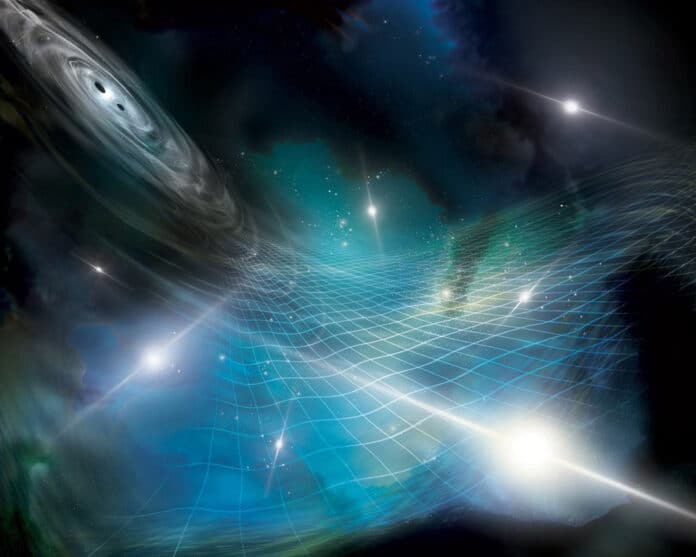Lower-frequency gravitational waves are thought to be produced by enormous black holes at the centers of galaxies, up to billions of times the mass of our sun, that lumber around each other slowly and have millions of years to go before merging. Higher-frequency gravitational waves are thought to be produced by smaller pairs of black holes that zip around each other quickly in the final seconds before they collide.
Scientists have discovered the first proof that gravitational waves, which ripple spacetime, are permeating the background of our cosmos and the Earth. It is believed that pairs of supermassive black holes that are leisurely spiraling together before they combine are the primary source of the waves, which oscillate very slowly over many years or even decades.
Thanks to 15 years’ worth of observations made by the North American Nanohertz Observatory for Gravitational Waves (NANOGrav), the study was possible. NANOGrav is thought to have picked up a collective hum of gravitational waves from many pairs of merging supermassive black holes throughout the universe.
Katerina Chatziioannou, a NANOGrav team member and an assistant professor of physics at Caltech, said, “People compare this signal to more of a background murmur as opposed to the shouts that LIGO picks up.”
The pulsar-timing array is another name for NANOGrav’s pulsar network. The pulsars, created when enormous stars explode, emit light beacons that quickly spin around at regular intervals. These pass past at a predictable rate, like lighthouse beacons. Timing can be predicted to be within tens of nanoseconds. In some instances, they are as accurate as atomic clocks.
Patrick Meyers, a NANOGrav team member and postdoctoral scholar research associate at Caltech, said, “These are like lighthouse beacons that sweep by regularly. You can predict the timing to a level of tens of nanoseconds. They have the same level of precision as atomic clocks in some cases.”
Gravitational waves slightly stretch and compress spacetime as they move across the universe. The timing of the pulsars’ light flashes can be delayed or advanced due to this stretching and constriction, which can cause the distance between Earth and a particular pulsar to shift minutely. The scientist’s team created software programs to examine the timing of pairs of pulsars in their network to look for the gravitational wave hum as a background noise source.
Joseph Lazio, a NANOGrav team member and a principal scientist at the Jet Propulsion Laboratory (JPL), said, “Imagine lots of ripples on an ocean from pairs of supermassive black holes scattered throughout. Now, we’re sitting here on Earth, which acts like a buoy along with the pulsars, and we try to measure how the ripples are changing and causing the other buoys to move toward and away from us.”
Michele Vallisneri, a NANOgrav team member and a senior research scientist at JPL, said, “To tease out the gravitational-wave background, we had to nail down a multitude of confusing effects, such as the motion of the pulsars, the perturbations due to the free electrons in our galaxy, the instabilities of the reference clocks at the radio observatories, and even the precise location of the center of the solar system, which we determined with help from NASA’s Juno and Cassini missions.”
A series of papers detailing the new NANOGrav results have been accepted for publication in The Astrophysical Journal Letters.
Journal Reference:
- Gabriella Agazie, Akash Anumarlapudi, Anne Archibald et al. The NANOGrav 15 yr Data Set: Evidence for a Gravitational-wave Background. The Astrophysical Journal Letters. DOI: 10.3847/2041-8213/acdac6
